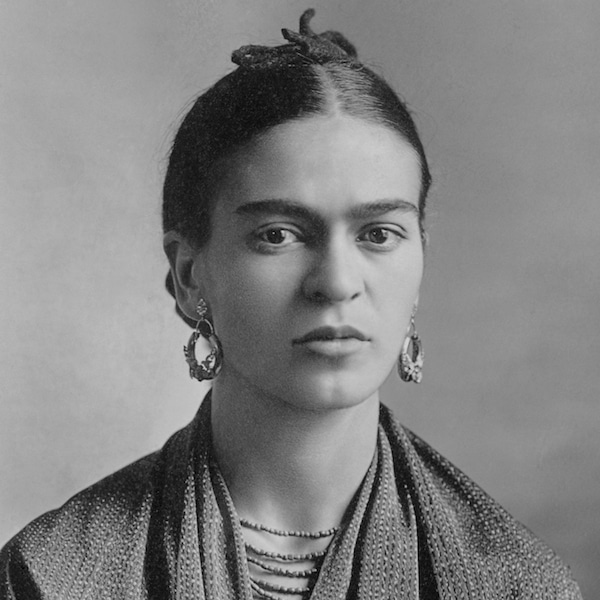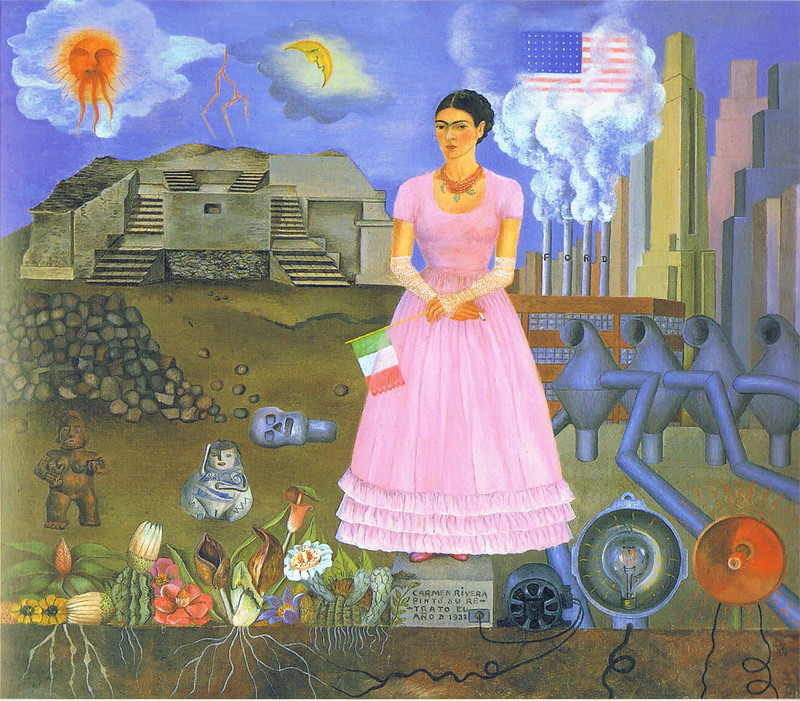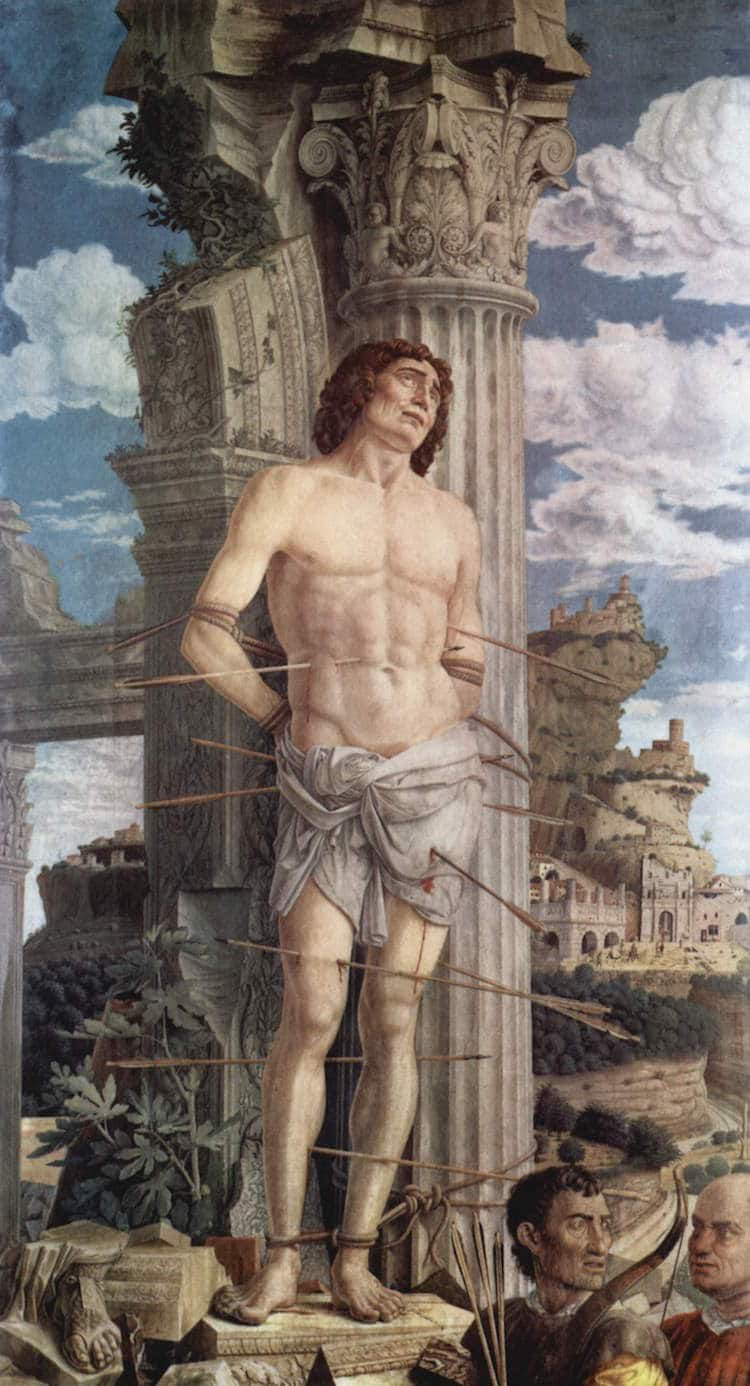What Art Was Frida Kahlo Most Famous for Frida Kahlo Most Famous Painting

Frida photographed by her begetter, Guillermo Kahlo, in 1932. (Photo: Guillermo Kahlo via Wikimedia Commons, Public domain)
Mexican painter Frida Kahlo is renowned for her symbolic subject thing, colorful canvases, and all-encompassing series of self-portraits. Inspired by "whatever passes through [her] caput without whatsoever other consideration," her paintings are deeply personal. Given the intimate and allegorical nature of her pieces, their messages and motifs may seem too obscure to interpret. When viewed through a contextual lens, however, the meanings behind her poignant paintings begin to materialize.
Kahlo explores several themes in her oeuvre, from an interest in her ancestry and heritage to her struggles with childlessness and femininity. Her well-nigh well-known paintings, nonetheless, seem to revolve around two major events in her life: her traumatic divorce from fellow creative person Diego Rivera, and a nearly fatal blow she survived as a teenager. Here, we contextualize seven of her most famous paintings in order to grasp the themes, thoughts, and emotions behind them.
Learn near 7 famous Frida Kahlo paintings.
Self-Portrait with Thorn Necklace and Hummingbird, 1940

Throughout the course of her career, Kahlo painted 55 portrayals of herself, including Self-Portrait with Thorn Necklace and Hummingbird . Today, this piece remains 1 of her about widely-recognized self-portraits, due to the moving context in which it was created and the symbolic nature of its imagery.
Kahlo completed this piece in 1940, one yr later on her tumultuous divorce from Mexican muralist Diego Rivera. Given the timing of its creation,Self-Portrait with Thorn Necklace and Hummingbird is widely believed to be a reflection of her emotional state following the couple's split up.
In the painting, Kahlo is positioned in forepart of leaf and between a stalking panther and a monkey. (She and Rivera had kept many monkeys as pets, leading many to speculate that they served equally surrogates for the children the couple was tragically unable to conceive.) Around her neck, she wears a necklace made out of thorns and adorned with a seemingly lifeless hummingbird. Though the peculiar accessory draws blood from her neck, her expression remains stoic. This calm approach to pain is typical of Kahlo, who—even when devastated over her divorce—poignantly stated that "at the stop of the mean solar day, we can endure much more than we call back we tin."
The Two Fridas, 1939

LikeSelf-Portrait with Thorn Necklace and Hummingbird , The Two Fridas was painted in response to Kahlo's separation from Rivera. In this slice, Kahlo explores two sides of herself. On the left, she depicts herself every bit a broken-hearted adult female clad in a traditionally European gown. On the right, her middle is whole, and she is wearing a modern Mexican dress—a way she adopted while married to Rivera.
As they share a bench, the ii Fridas hold hands. This encompass, even so, is not all that connects them; from their hearts sprouts a unmarried vein, which branches out and wraps around their artillery. On the left, Frida cuts the vein with surgical pair of scissors, causing it to bleed. On the right, the vein leads to a tiny portrait of Rivera, clutched by Frida and nearly invisible to the unobservant eye.
This unique cocky-portrait probable represents the inner identity struggle faced past Kahlo as she dealt with her divorce. Though surreal in subject matter, Kahlo insisted that such iconography was rooted in existent-life and, therefore, a direct reflection of her persona. "I never paint dreams or nightmares," she explained. "I paint my ain reality."
Self Portrait with Cropped Hair, 1940

Following her divorce, Kahlo sought to reinvent herself. In an act of disobedience against her ex-husband, she painted Self Portrait with Cropped Pilus.
Seated on a bright yellow chair with scissors in manus and locks of hair surrounding her, the creative person is shown with a short haircut and clad in a man's adapt. Above her floats a pertinent lyric from a Mexican folk song. When translated, it reads: "Look, if I loved you it was because of your hair. At present that yous are without hair, I don't honey you anymore."
Clearly, Kahlo's androgynous approach to her appearance inSelf Portrait with Cropped Hair is a far cry from the long hair, flowing dresses, and feminine jewelry exhibited in virtually depictions of her. Fascinatingly, still, this is non the offset fourth dimension she has experimented with a masculine look. In photos of the artist as a child and teenager, information technology is apparent that she frequently wore suits—even when her female friends and family retained a more "feminine" appearance.
Self-Portrait on the Borderline Between Mexico and the United states of america, 1932

Kahlo and Rivera lived in America for a menses of iv years, between 1930–1934. While her married man thrived in the limelight and found neat success amongst artistic circles, Kahlo experienced many hardships, including failed pregnancies. Self-Portrait on the Borderline Between Mexico and the U.s. depicts Kahlo'due south dislike for the industrial and capitalist civilisation of the U.Due south. besides as her longing for the agrestal lifestyle of United mexican states.
On the right is a simplified portrayal of Detroit—one of the cities in which she and River lived—which is made up of alpine skyscrapers and a manufacturing plant producing plumes of smoke. On the left is an illustration of Mexico, featuring plants, vegetables, ancient statues, a skull, and temple ruins in the background. Although Kahlo was deeply unhappy during this period, she grew considerably equally an artist and was able to experiment in different mediums.
My Grandparents, My parents, and I (Family unit Tree), 1936
 My Grandparents, My Parents, and I is one of two family tree paintings Kahlo ever created. It documents her mixed-race heritage, with her Mexican mother and Mexican maternal grandparents on the left, and her German begetter and German grandparents on the right. Kahlo includes a depiction of herself every bit a young child standing at the center and holding the ribbon that ties all of these figures together.
My Grandparents, My Parents, and I is one of two family tree paintings Kahlo ever created. It documents her mixed-race heritage, with her Mexican mother and Mexican maternal grandparents on the left, and her German begetter and German grandparents on the right. Kahlo includes a depiction of herself every bit a young child standing at the center and holding the ribbon that ties all of these figures together.
The Broken Column, 1944
"In that location have been ii corking accidents in my life. One was the train, the other was Diego. Diego was by far the worst." In 1925, 18-year-sometime Kahlo was involved in a streetcar accident that left her with a broken spinal column, among many other major injuries. In Broken Cavalcade , Kahlo presents a tragic glimpse into the lifelong effects of the accident.
The painting depicts Kahlo afterwards spinal surgery. Nude except for a hospital sheet and a metal corset, her body is pierced with nails (perchance equally an allusion to Christian iconography of Christ on the cross)—and is shown carve up open. Visible in the crack that bisects her trunk is a crumbling Ionic column, which has replaced her spine and symbolizes her cleaved body. In the background, a barren mural is similarly fissured, and a stormy sky looms overhead.
In 1929, Kahlo painted The Motorcoach , a depiction that recalls what she had seen moments before the life-altering blow.
The Wounded Deer (1946)
The Wounded Deer is another self-portrait that symbolically addresses the physical and emotional pain associated with Kahlo's injuries.
In the piece, Kahlo has depicted herself as a deer—a choice peradventure inspired by her dear pet, Granizo. Struck past arrows and positioned backside a broken branch (an object used in traditional Mexican funeral rites), it is clear that the deer is probable going to die. At the time of the painting's creation, Kahlo's health was in decline. In add-on to failed cosmetic surgeries and the ongoing physical pain associated with her blow, she also suffered from gangrene and other illnesses.
Furthermore, likeThe Broken Cavalcade, The Wounded Deer references Christian iconography. According to the bible, Saint Sebastian, an early on Christian saint, and martyr, was killed by an onslaught of arrows. His death has remained a popular subject in art for centuries, and probable inspired Kahlo's choice of discipline matter.

"St. Sebastian" (panel) by Andrea Mantagna (1480). (Photograph: Andrea Mantegna, Public domain, via Wikimedia Commons)
Sadly, Kahlo passed away in 1954. Cheers to her highly personal arroyo to fine art, however, her innermost emotions and admirable imagination are perpetually preserved in a captivating drove of works.
This article has been edited and updated.
Related Articles:
Rare Photos of Frida Kahlo as a Young Woman in the 1920s
Art History Masterpieces Reimagined equally Manus-Sewn Embroidery
Ambrosial Frida Kahlo Action Figure Features Iconic Unibrow and Detachable Heart
Iconic Artists Who Have Immortalized Themselves Through Famous Self-Portraits
Posting Komentar untuk "What Art Was Frida Kahlo Most Famous for Frida Kahlo Most Famous Painting"